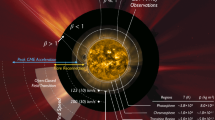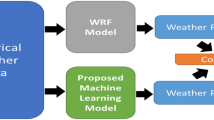Abstract
The paper proposes a model for predicting the integral daily fluxes (fluences) of relativistic electrons (RE) (E > 2 MeV) of the Earth's outer radiation belt in a geostationary orbit using images of the Sun in the ultraviolet range. The results show that the accuracy of the forecast of the RE fluxes three or four days ahead increases significantly when adding the predicted values of solar wind speed at the Earth’s orbit, obtained by processing images of the Sun in the UV range from AIA instrument, SDO Observatory, to the input parameters of the forecasting model.





Similar content being viewed by others
REFERENCES
Baker, D.N., McPherron, R.L., Cayton, T.E., and Kebesadel, R.W., Linear prediction filter analysis of relativistic electron properties at 6.6 RE, J. Geophys. Res., 1990, vol. 95, no. A9, pp. 15133–15140.
Belov, A.V., Villoresi, J., Dorman, L.I., Eroshenko, E.A., Levitin, A.E., Parisi, M., Ptitsyna, N.G., Tyasto, M.I., Chizhenkov, V.A., Jucci, N., and Yanke, V.G., Effect of the space on operation of satellites, Geomagn. Aeron. (Engl. Transl.), 2004, vol. 44, no. 4, pp. 461–468.
Bortnik, J., Chu, X., Ma, Q., Li, W., Zhang, X., Thorne, R.M., et al., Artificial neural networks for determining magnetospheric conditions, in Machine Learning Techniques for Space Weather, Camporeale, E., Wing, S., and Johnson, J.R., Eds., Elsevier, 2018, pp. 179–300.
Cole, D.G., Space weather: Its effects and predictability, Space Sci. Rev., 2003, vol. 107, pp. 295–302.
Friedel, R.H., Reeves, W.G.P., and Obara, T., Relativistic electron dynamics in the inner magnetosphere: A review, J. Atmos. Sol.-Terr. Phys., 2002, vol. 64, pp. 265–283.
Fukata, M., Taguchi, S., Okuzawa, T., and Obara, T., Neural network prediction of relativistic electrons at geosynchronous orbit during the storm recovery phase: Effects of recurring substorms, Ann. Geophys., 2002, vol. 20, no. 7, pp. 947–951.
Harvey, J.W. and Sheeley, N.R., Coronal holes, solar wind streams, and geomagnetic activity during the new sunspot cycle, Sol. Phys., 1978, vol. 59, pp. 159–173.
Khaikin, S., Neironnye seti: polnyi kurs (Neural Networks: A Complete Course), Moscow: Vil’yams, 2006.
Koons, H.C. and Gorney, D.J., A neural network model of the relativistic electron flux at geosynchronous orbit, J. Geophys. Res., 1990, vol. 96, pp. 5549–5556.
Krista, L.D. and Gallagher, P.T., Automated coronal hole detection using local intensity thresholding techniques, Sol. Phys., 2009, vol. 256, no. 1, pp. 87–100.
Kudela, K., Space weather near earth and energetic particles: Selected results, J. Phys.: Conf. Ser., 2013, vol. 409, no. 1, id 012017. https://doi.org/10.1088/1742-6596/409/1/012017
Ling, A.G., Ginet, G.P., Hilmer, R.V., and Perry, K.L., A neural network-based geosynchronous relativistic electron flux forecasting model, Space Weather, 2010, vol. 8, id S09003. https://doi.org/10.1029/2010SW000576
Machine Learning Techniques for Space Weather, Camporeale, E., Wing, S., and Johnson, J.R., Eds., Elsevier, 2018. https://doi.org/10.1016/C2016-0-01976-9
Myagkova, I.N., Panasyuk, M.I., Denisov, Yu.I., et al., Correlation between the Earth’s outer radiation belt dynamics and solar wind parameters at the solar minimum according to EMP instrument data onboard the CORONAS-Photon satellite, Geomagn. Aeron. (Engl. Transl.), 2011, vol. 51, no. 7, pp. 897–901.
Myagkova, I.N., Shugai, Yu.S., Veselovskii, I.S., and Yakovchuk, O.S., Comparative analysis of recurrent high-speed solar wind streams influence on the radiation environment of near-earth space in April–July 2010, Sol. Syst. Res., 2013, vol. 47, no. 2, pp. 127–140.
Myagkova, I.N., Dolenko, S.A., Efitorov, A.O., Shirokii, V.R., and Sentemova, N.S., Prediction of relativistic electron flux in the Earth’s outer radiation belt at geostationary orbit by adaptive methods, Geomagn. Aeron. (Engl. Transl.), 2017, vol. 57, no. 1, pp. 8–15.
Nolte, J.T., Krieger, A.S., Timothy, A.F., Gold, R.E., Roelof, E.C., Vaiana, G., Lazarus, A.J., Sullivan, J.D., and McIntosh, P.S., Coronal holes as sources of solar wind, Sol. Phys., 1976, vol. 46, pp. 303–322.
Paulikas, G.A. and Blake, J.B., Effects of the solar wind on magnetospheric dynamics: Energetic electrons at the synchronous orbit, in Quantitative Modeling of Magnetospheric Processes, Olson, W.P., Ed., Washington, DC: AGU, 1979, pp. 180–202. https://doi.org/10.1029/GM021p0180
Pulkkinen, T., Space weather: Terrestrial perspective, Living Rev. Sol. Phys., 2007, vol. 4, id 1. http://www.livingreviews.org/lrsp-2007-1. Accessed September 18, 2007.
Reeves, G.D., McAdams, K.L., Friedel, R.H.W., and O’Brien, T.P., Acceleration and loss of relativistic electrons during geomagnetic storms, Geophys. Res. Lett., 2003, vol. 30, 1529. https://doi.org/10.1029/2002GL016513
Reeves, G.D., Morley, S.K., Friedel, R.H.W., Henderson, M.G., Cayton, T.E., Cunningham, G., Blake, J.B., Christensen, R.A., and Thomsen, D., On the relationship between relativistic electron flux and solar wind velocity: Paulikas and Blake revisited, J. Geophys. Res., 2011, vol. 116, A02213. https://doi.org/10.1029/2010JA015735
Romanova, N.V., Pilipenko, V.A., Yagova, N.V., and Belov, A.V., Statistical correlation of the rate of failures on geosynchronous satellites with fluxes of energetic electrons and protons, Cosmic Res., 2005, vol. 43, no. 3, pp. 179–185.
Shin, D.-K., Lee, D.-Y., Kim, K.-C., Hwang, J., and Kim, J., Artificial neural network prediction model for geosynchronous electron fluxes: Dependence on satellite position and particle energy, Space Weather, 2016, vol. 14, no. 4, pp. 313–321.
Shugay, Y.S., Veselovsky, I.S., Seaton, D.B., and Berghmans, D., Hierarchical approach to forecasting recurrent solar wind streams, Sol. Syst. Res., 2011, vol. 45, pp. 546–556.
Shugay, Yu., Slemzin, V., Rodkin, D., Yermolaev, Yu., and Veselovsky, I., Influence of coronal mass ejections on parameters of high-speed solar wind: A case study, J. Space Weather Space Clim., 2018, vol. 8, no. A28. https://doi.org/10.1051/swsc/2018015
Simms, L.E., Engebretson, M.J., Pilipenko, V., Reeves, G.D., and Clilverd, M., Empirical predictive models of daily relativistic electron flux at geostationary orbit: Multiple regression analysis, J. Geophys. Res.: Space Phys., 2016, vol. 121, pp. 3181–3197. https://doi.org/10.1002/2016JA022414
Turner, D.L., Shprits, Y., Hartinger, M., and Angelopoulos, V., Explaining sudden losses of outer radiation belt electrons during geomagnetic storms, Nat. Phys., 2012, vol. 8, pp. 208–212.
Varotsou, A., Boscher, D., Bourdarie, S., Horne, R.B., Glauert, S.A., and Meredith, N.P., Simulation of the outer radiation belt electrons near geosynchronous orbit including both radial diffusion and resonant interaction with whistler-mode chorus waves, Geophys. Res. Lett., 2005, vol. 32, L19106. https://doi.org/10.1029/2005GL023282
Vršnak, B., Temmer, M., and Veronig, A.M., Coronal holes and solar wind high-speed streams: I. Forecasting the solar wind parameters, Sol. Phys., 2007, vol. 240, pp. 315–330.
Funding
The work was supported by the Russian Science Foundation, project no. 16-17-00098-P.
Author information
Authors and Affiliations
Corresponding author
Additional information
Translated by A. Nikol’skii
Rights and permissions
About this article
Cite this article
Myagkova, I.N., Shugai, Y.S., Kalegaev, V.V. et al. Medium-Term Prediction of Relativistic Electron Fluxes in a Geostationary Orbit Using Machine Learning Methods Based on Observations of Solar Coronal Holes. Geomagn. Aeron. 60, 279–288 (2020). https://doi.org/10.1134/S0016793220030123
Received:
Revised:
Accepted:
Published:
Issue Date:
DOI: https://doi.org/10.1134/S0016793220030123




